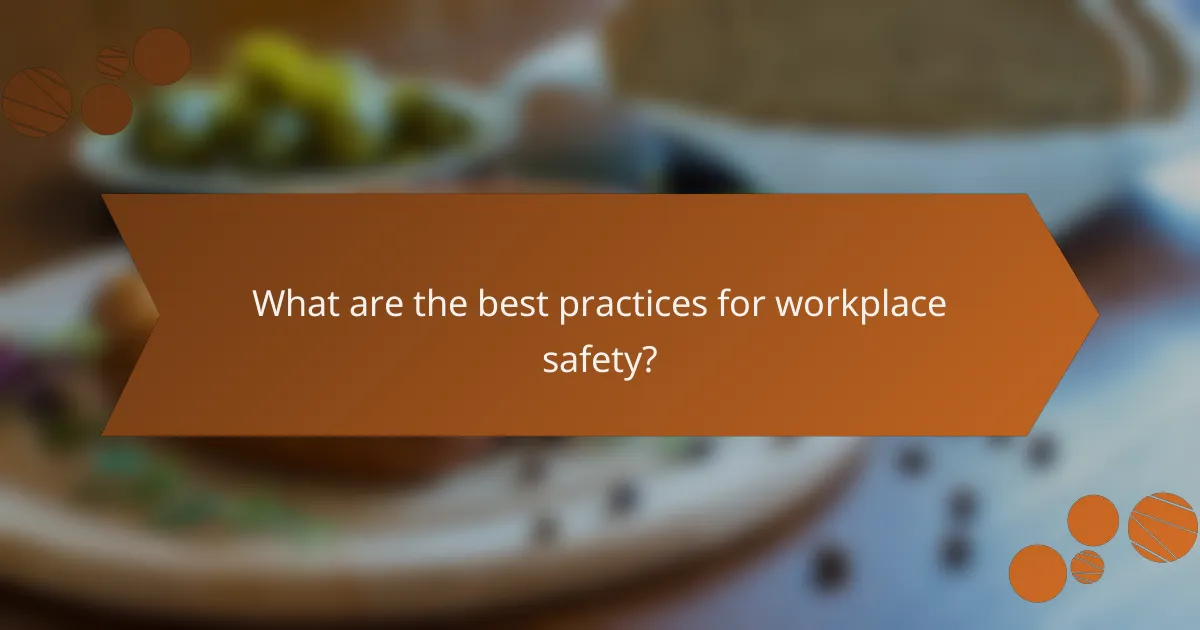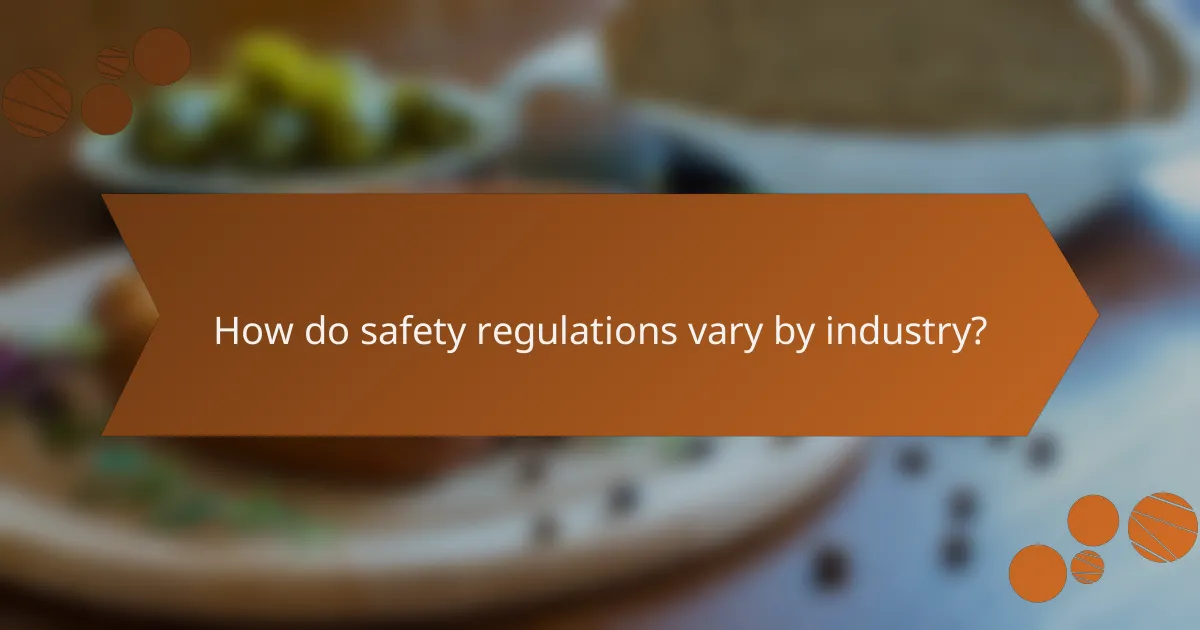Safety regulations in construction are essential for protecting workers and ensuring compliance with legal standards. Key organizations, such as OSHA and the EPA, set forth guidelines that businesses must follow to maintain safe work environments. By implementing systematic processes, including regular audits and comprehensive training, companies can effectively manage risks and adhere to these regulations. Adopting best practices, such as using personal protective equipment and conducting risk assessments, further enhances workplace safety and compliance.

What are the key safety regulations in construction?
The key safety regulations in construction include standards set by organizations such as OSHA, local building codes, and guidelines from the Environmental Protection Agency (EPA). These regulations ensure that construction sites are safe for workers and compliant with environmental standards.
OSHA standards
OSHA, the Occupational Safety and Health Administration, establishes regulations to ensure safe working conditions in the construction industry. These standards cover a wide range of topics, including fall protection, scaffolding safety, and hazard communication.
Compliance with OSHA standards is mandatory for all construction projects in the United States. Employers must provide training, safety equipment, and a safe working environment to minimize risks and protect workers from injuries.
Local building codes
Local building codes are regulations established by municipalities to ensure that construction meets safety, health, and structural integrity standards. These codes can vary significantly from one location to another and often include requirements for materials, design, and construction practices.
Before starting a construction project, it is crucial to consult local building codes to avoid fines and ensure compliance. Engaging with local authorities early in the planning process can help identify specific requirements and streamline the approval process.
Environmental Protection Agency (EPA) guidelines
The EPA provides guidelines to protect the environment during construction activities. These regulations address issues such as waste disposal, air quality, and water runoff management. Compliance with EPA guidelines helps prevent pollution and protects natural resources.
Construction projects must adhere to these guidelines to minimize environmental impact. For example, implementing erosion control measures and proper waste management practices can help ensure compliance and promote sustainability on construction sites.

How can businesses ensure compliance with safety regulations?
Businesses can ensure compliance with safety regulations by implementing systematic processes, including regular audits, comprehensive training programs, and thorough documentation of safety practices. These steps help identify risks, educate employees, and maintain records that demonstrate adherence to legal requirements.
Regular safety audits
Conducting regular safety audits is essential for identifying potential hazards and ensuring compliance with safety regulations. These audits should be scheduled at least annually and can be performed by internal teams or external consultants to provide an unbiased assessment.
During an audit, evaluate equipment, workspaces, and safety protocols. Use checklists to cover all relevant areas, and prioritize findings based on risk levels. Addressing high-risk issues promptly can significantly reduce accidents and liability.
Employee training programs
Implementing robust employee training programs is crucial for fostering a culture of safety. Training should cover essential safety practices, emergency procedures, and the proper use of personal protective equipment (PPE). Regular refresher courses can help maintain awareness and compliance.
Consider tailoring training sessions to specific roles within the organization, as different positions may face unique hazards. Engaging employees through hands-on training and simulations can enhance retention and application of safety knowledge.
Documentation of safety practices
Thorough documentation of safety practices is vital for demonstrating compliance with regulations and for internal accountability. Maintain records of safety audits, training sessions, incident reports, and corrective actions taken to address safety issues.
Establish a centralized system for storing documentation, making it easily accessible for audits and inspections. Regularly review and update safety policies to reflect changes in regulations or operational practices, ensuring that all documentation remains current and relevant.

What are the best practices for workplace safety?
The best practices for workplace safety include implementing comprehensive safety protocols, utilizing personal protective equipment (PPE), and conducting regular risk assessments. These practices help to minimize hazards, protect employees, and ensure compliance with safety regulations.
Implementing safety protocols
Implementing safety protocols involves establishing clear guidelines and procedures to manage workplace hazards. This includes creating a safety manual, conducting training sessions, and ensuring all employees understand their roles in maintaining a safe environment.
Regularly reviewing and updating these protocols is essential to adapt to new regulations or changes in the workplace. For example, a construction site may need to revise its safety protocols when introducing new machinery or materials.
Using personal protective equipment (PPE)
Using personal protective equipment (PPE) is crucial for safeguarding employees from potential injuries. Common types of PPE include helmets, gloves, eye protection, and respiratory gear, depending on the specific risks present in the workplace.
Employers should assess the necessary PPE based on the tasks performed and ensure proper training on its use. Regular inspections and maintenance of PPE are also vital to ensure its effectiveness and compliance with safety standards.
Conducting risk assessments
Conducting risk assessments is a proactive approach to identifying and mitigating workplace hazards. This process involves evaluating the environment, equipment, and tasks to determine potential risks and their impact on employees.
Employers should perform risk assessments regularly and involve employees in the process to gain insights into potential hazards. Documenting findings and implementing corrective actions can significantly reduce the likelihood of accidents and injuries in the workplace.

What are the consequences of non-compliance with safety regulations?
Non-compliance with safety regulations can lead to significant financial, legal, and reputational consequences for businesses. Organizations may face fines, increased liability risks, and damage to their public image, which can affect their overall operations and profitability.
Fines and penalties
Fines for non-compliance can vary widely depending on the severity of the violation and the specific regulations involved. In many cases, penalties can range from hundreds to thousands of dollars per violation, with repeat offenders facing even steeper fines. Additionally, regulatory bodies may impose daily fines for ongoing non-compliance, which can quickly accumulate.
Companies should regularly review their compliance status to avoid these financial penalties. Implementing a robust safety management system can help identify potential issues before they lead to costly fines.
Increased liability risks
Non-compliance can significantly increase liability risks for businesses, exposing them to lawsuits and claims from employees, customers, or third parties. If an incident occurs due to non-compliance, companies may find it difficult to defend themselves in court, leading to substantial settlements or judgments.
To mitigate these risks, businesses should ensure they are up-to-date with safety regulations and conduct regular training for employees. Documenting compliance efforts can also provide crucial evidence in case of legal disputes.
Reputation damage
Failure to comply with safety regulations can severely damage a company’s reputation. Negative publicity from accidents or regulatory actions can lead to a loss of customer trust and loyalty, which may take years to rebuild. In a competitive market, a tarnished reputation can result in decreased sales and market share.
To protect their reputation, organizations should prioritize compliance and actively communicate their commitment to safety. Engaging with stakeholders and demonstrating transparency in safety practices can help maintain a positive public image.

How do safety regulations vary by industry?
Safety regulations differ significantly across industries due to the unique risks and operational environments each sector faces. Understanding these variations is crucial for compliance and effective risk management.
Construction industry regulations
The construction industry is governed by strict safety regulations aimed at preventing accidents and injuries on job sites. Key regulations often include guidelines on personal protective equipment (PPE), scaffolding safety, and fall protection measures.
For example, the Occupational Safety and Health Administration (OSHA) in the United States mandates that employers provide fall protection for workers at elevations of six feet in the construction industry. Regular safety training and inspections are essential to ensure compliance and minimize hazards.
Manufacturing industry standards
Manufacturing safety standards focus on machinery safety, chemical handling, and workplace ergonomics. Regulations often require manufacturers to implement safety protocols like lockout/tagout procedures to prevent accidental machine startups during maintenance.
In the European Union, the Machinery Directive outlines essential health and safety requirements for machinery used in manufacturing. Regular risk assessments and employee training are critical to maintaining a safe working environment and adhering to these standards.
Healthcare safety protocols
Healthcare safety protocols are designed to protect both patients and healthcare workers from various risks, including infections and hazardous materials. Key regulations often involve infection control practices, proper handling of medical waste, and the use of PPE.
For instance, the Centers for Disease Control and Prevention (CDC) provides guidelines for infection prevention in healthcare settings, emphasizing hand hygiene and the use of sterile equipment. Compliance with these protocols is vital for ensuring patient safety and reducing the spread of infections.

What are the emerging trends in safety regulations?
Emerging trends in safety regulations focus on the integration of advanced technologies, data analytics, and a proactive approach to compliance. Organizations are increasingly adopting digital tools to enhance safety measures and streamline regulatory adherence.
Integration of technology in compliance
The integration of technology in compliance involves using software and hardware solutions to monitor safety standards and ensure adherence to regulations. This can include real-time data collection, automated reporting, and predictive analytics to identify potential hazards before they escalate.
For example, companies are utilizing wearable devices that track worker health metrics, providing insights into fatigue levels or exposure to harmful environments. This data can help organizations adjust workflows and improve safety protocols effectively.
To successfully implement technology in compliance, organizations should prioritize user-friendly systems that integrate seamlessly with existing processes. Regular training and updates are essential to keep staff informed about new tools and best practices, minimizing resistance to change and enhancing overall safety culture.
